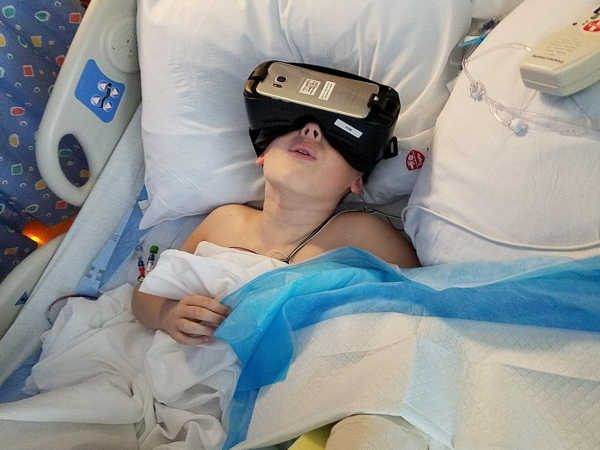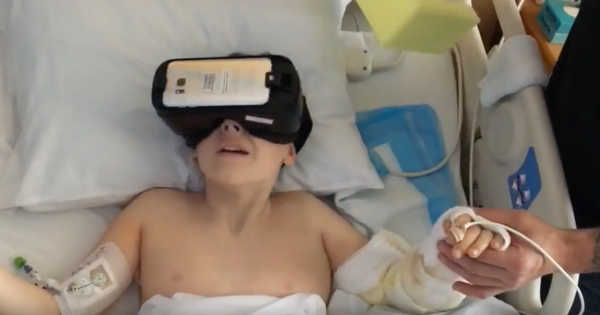Virtual reality (VR) technology has been shown to be effective in reducing the pain associated with dressing changes in children with burn injuries. The use of smartphone-based VR games during dressing changes in pediatric burn patients was investigated in a study led by Dr. Henry Xiang, Professor of Pediatrics and Epidemiology at Nationwide Children’s Hospital and Director of the Center for Pediatric Trauma Research. The team came to the conclusion that the game was extremely effective at reducing patient-reported pain.
Prior research has looked into distraction-based approaches to pain relief in burn injury patients, such as music, hypnosis, toys, and virtual reality (VR). A team of researchers has now reported the use of smartphone-based VR games during dressing changes in pediatric burn patients.
Burn injuries affect approximately 250,000 children in the United States each year, according to the American Burn Association. The pain associated with burn injuries extends beyond the injury itself; there is also significant pain associated with dressing changes, which can be exacerbated by the anxiety associated with this additional pain.
Although opioids alleviate the pain associated with burn injuries, they have serious side effects. Prior research has looked into distraction-based approaches to pain relief in burn injury patients, such as music, hypnosis, toys, and virtual reality (VR).
Prior studies have investigated alternative approaches to pain reduction in burn injury patients that focus on distraction, such as music, hypnosis, toys, and virtual reality (VR).
Henry Xiang, MD, MPH, Ph.D., MBA, and his colleagues reported the use of smartphone-based VR games during dressing changes in pediatric patients with burn injuries in a study published today in JAMA Network Open. “The smartphone-based VR game was very effective in reducing patient-reported pain,” says Dr. Xiang, director of the Center for Pediatric Trauma Research and a professor of pediatrics and epidemiology at Nationwide Children’s Hospital.
The research team divided 90 children, aged 6 to 17 years, into three treatment groups in the pilot study, which was designed as a randomized clinical trial: active VR, passive VR, and standard care (e.g., toys, tablets). Between December 2016 and January 2019, these patients, the majority of whom had second-degree burns, received outpatient burn care.
The “Virtual River Cruise” VR game was created specifically for the study by the Nationwide Children’s Research Information Solutions and Innovation department. “Two factors were considered in the game’s design,” Dr. Xiang explains. “The first factor was the game’s snowy, cool environment. The second factor was cognitive processing, which was used to encourage active participation.”

Patients used a smartphone and a headset to play the game. Patients in the active VR group actively engaged with the game during dressing changes, which lasted about 5 to 6 minutes; to stay still while playing the game, the patients tilted their heads to aim a target, notes Dr. Xiang. Patients in the passive VR group did nothing but watch the game.
In post-intervention surveys, patients and caregivers reported their perceived pain and subjective experience with the game. The clinical utility of the game was assessed by nurses. Patients in the active VR group had the lowest overall pain scores of the three treatment groups. The game was described as “fun, engaging, and realistic” by the majority of patients and caregivers.
The game was deemed clinically useful in the outpatient setting by nurses. Previously, computer-based games were used to pass the time while changing clothes. However, the computers’ bulkiness made them unsuitable for clinical use. “Smartphones are simple to use, and most families have them,” Dr. Xiang said.
Dr. Xiang believes that VR games can be played at home to relieve pain due to their ease of use and demonstrated effectiveness in reducing pain during burn dressing changes. “After hospital discharge, pediatric burn patients still require dressing changes at home, and these changes can be very painful,” Dr. Xiang explained. Dr. Xiang is currently leading a research project funded by the Division of Emergency Medical Service of the Ohio Department of Public Safety to assess the feasibility and efficacy of virtual reality games in reducing pain during burn dressing changes at home.
The game was reported to be clinically useful in the outpatient setting by nurses. Previously, computer-based games were used to pass the time while changing clothes. However, the computers’ bulkiness made them unsuitable for clinical use.
The current opioid crisis emphasizes the importance of continuing to investigate non-opioid approaches to pain control in burn patients. “The next step in the research will be to see if smartphone-based VR games have an opioid-sparing effect,” says Dr. Xiang.














